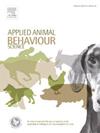Behavioural indicators of infectious disease in managed animals
IF 2.2
2区 农林科学
Q1 AGRICULTURE, DAIRY & ANIMAL SCIENCE
引用次数: 0
Abstract
Identifying reliable and valid behavioural indicators of infection in managed animals is increasingly important as the risks of emergent diseases increase alongside concomitant concerns over pathogen resistance and the environmental and safety impacts of traditional therapeutic treatments. Early behavioural detection of disease could help to curb transmission, assist in selecting resilient animals and guide facility design to help animals avoid infection and to support their recovery. This review explores the adaptability and flexibility of animal responses to pathogens, including behaviours that (i) favour disease avoidance (ii) are associated with immune activation (iii) directly resist pathogens (iv) are dysregulated leading to hypersensitivity and (v) are associated with pathogen tolerance. A key theme is that all of these behavioural responses are strongly modulated by contextual factors such as pain, hunger and social priorities. Efforts to develop and validate, and increasingly automate, behavioural indicators of infection have so far primarily focused on infection-induced changes in core behaviours such as feeding and general activity or on hypothesis-free machine-learning comparison. However, such approaches have limited specificity, sensitivity and may be hard to generalise across contexts. The current review suggests ways in which specificity could be improved by monitoring changes in behaviours that are more closely linked to immune activation e.g. sleep, attention and motor function, by a more granular focus, and by integration with clinical symptoms. It also proposes that sensitivity could be improved by monitoring pliant (“luxury”) behaviours and by intentional challenges or tests. Improved knowledge of how animals behave when infected could be used to design environments where the costs of resistance or tolerance are reduced and where recovery is promoted.
求助全文
约1分钟内获得全文
求助全文
来源期刊

Applied Animal Behaviour Science
农林科学-行为科学
CiteScore
4.40
自引率
21.70%
发文量
191
审稿时长
18.1 weeks
期刊介绍:
This journal publishes relevant information on the behaviour of domesticated and utilized animals.
Topics covered include:
-Behaviour of farm, zoo and laboratory animals in relation to animal management and welfare
-Behaviour of companion animals in relation to behavioural problems, for example, in relation to the training of dogs for different purposes, in relation to behavioural problems
-Studies of the behaviour of wild animals when these studies are relevant from an applied perspective, for example in relation to wildlife management, pest management or nature conservation
-Methodological studies within relevant fields
The principal subjects are farm, companion and laboratory animals, including, of course, poultry. The journal also deals with the following animal subjects:
-Those involved in any farming system, e.g. deer, rabbits and fur-bearing animals
-Those in ANY form of confinement, e.g. zoos, safari parks and other forms of display
-Feral animals, and any animal species which impinge on farming operations, e.g. as causes of loss or damage
-Species used for hunting, recreation etc. may also be considered as acceptable subjects in some instances
-Laboratory animals, if the material relates to their behavioural requirements
 求助内容:
求助内容: 应助结果提醒方式:
应助结果提醒方式:


